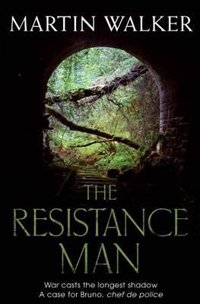The Bruno, chef de police series has been my guilty reading pleasure ever since I discovered them a few months ago. The books are a delight for the senses, set in the picturesque Dordogne region of France, replete with mouth-watering recipes, full to the brim with eccentric characters. This book is the sixth to feature charming local policeman Bruno Courrèges and does not stray from the formula which has made the series so successful.
Yet The Resistance Man is anything but formulaic. The author has a solid journalistic background, as well as a holiday home in the Dordogne, so there is plenty of depth, quirky cultural observation and canny political commentary to enjoy. The mystery itself is perhaps less intriguing than in previous books, but it makes for an enjoyable read nevertheless, linking past and present quite skillfully.
When one of the last surviving Resistance fighters dies in the village of St Denis, Bruno expects he will have to make arrangements for a special funeral. What he doesn’t expect is for the old man to be clutching old banknotes which appear to be linked to a legendary train robbery of 1944 organised by the French Resistance. The money was never recovered, although after World War II many former Resistance leaders were rumoured to have suddenly bought large houses, started businesses and financed political careers. Bruno barely has time to pursue this investigation because a spate of burglaries is plaguing the local area.
Then, a further burglary at a rental villa ends in murder. The victim is an English antiques dealer, and his French boyfriend is soon suspected of murdering him in a jealous fit. Or is there a connection with the burglary at the house of another Englishman, an influential former head of Britain’s Joint Intelligence Committee? And just what has the French-American historian Jacqueline discovered that could be so politically damaging?
Bruno may be the only policeman in the village, but he is never alone in pursuing the culprits. In this tight-knit community, he is ably aided by his usual bevy of bright and beautiful women: ambitious former lover Isabelle, self-assured Pamela, the doctor Fabiola, young magistrate Annette and local gendarme Françoise. These friends cook for each other, enjoy each other’s company and wine… and get to solve a few mysteries along the way. Bruno himself is almost too good to be true. He grows his own vegetables, puts together delicious gourmet meals, is gentle with animals and reluctant to carry a gun. No wonder he is so popular with the ladies! If this sounds a little escapist, that’s because the series certainly is, and for some this may be a turn-off. The author has even dedicated a website to Bruno and the touristic and culinary delights of the Perigord region.
This is Midsomer Murders crossed with Peter Mayle’s accounts of life in the Provence. It’s cosy crime writing at its most beguiling and may not suit those looking for faster-paced action or complex mystery. You don’t have to read the books in order. There is enough background information to start with any book in the series. You may want to pace yourself, though. Reading them in quick succession may feel a bit like overindulging in the truffles, for which this region is famous. Taken in moderation, however, this makes for a very refreshing and delightful read. The previous novel, The Devil’s Cave, has a more enthralling storyline and is now available in paperback.
Quercus
Print/Kindle/iBook
£7.12
CFL Rating: 4 Stars
